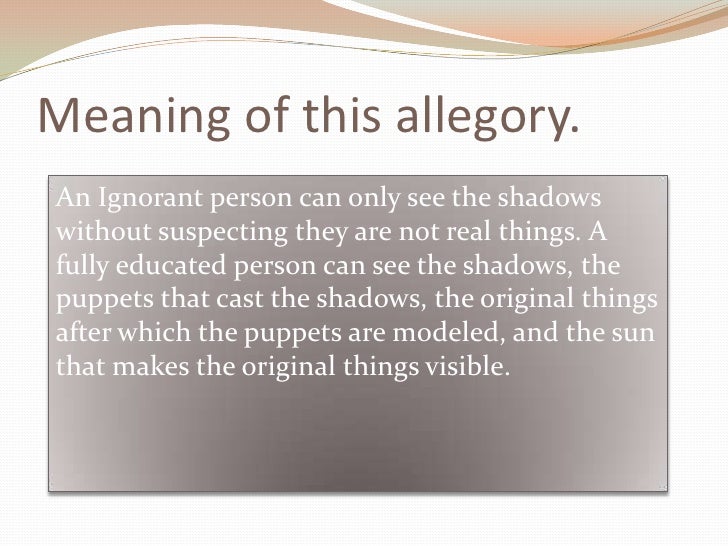
The Allegory of the Cave is closely linked to Joseph Campbell's theory: Hero's Journey and Dan Harmon's Story Circle. You might wonder what utility Allegory of the Cave has in the practical work of writing your screenplay.
#Cave allegory explained how to#
How to use allegory in your screenwriting If you want to incorporate some of these ideas into your screenplay or are particularly interested in meta-narrative, then it is well worth making some notes that you can refer back to later. You can read a more detailed summary of the Allegory of the Cave as part of Plato's Republic here. It is a classic work of literature well worth investigating for yourself. Where can you read the Allegory of the Cave?įollowing this link, you can read the original Plato's Allegory of the Cave. Narratives exist within a cave so that we as an audience exit when we leave the cinema or turn off our television, adjusting to the light of our own safe world, removed from the ideas presented to us in the film. The Cave story also reveals something more fundamental about narrative itself. And when we don't, we will no longer be able to step back into the darkness so easily. If we open our minds to new ideas and belief systems, we can expand our universe. Plato's Cave has at its heart internal conflict. The world is only as big as we can imagine. The hidden message of Plato's Cave is an escape from ignorance. However, one prisoner manages to escape, and somebody drags one of the prisoners around the fire and into the real world. To the prisoners in the Cave who have lived there since early childhood, this is what they believe to be their world.
#Cave allegory explained series#
A series of people they can't see project shadow puppets onto the wall in front of them. A bright fire is burning behind them, seemingly preventing them from escaping. The story is told as a dialogue between philosophers Glaucon and Socrates, narrated by Socrates.Ī group of prisoners live in a cave. In much the same way, Orwell's Animal Farm is not really about animals but what those animals represent, so the Cave is not really about a cave. Plato’s Allegory of the Cave is an allegory: a story with a hidden meaning. Here's Plato's Allegory of the Cave: explained. Learning about it can fundamentally change how you approach writing screenplays.



It is one of history's most important philosophical works dating back thousands of years. Read through it and compare the two texts presented.Have you ever wondered how philosophy and narrative intersect? Where the difference lies between a film and reality? One way we decipher this complex message is through Plato’s Allegory of The Cave. Interested in comparing Plato’s Allegory of the Cave to a real-life issue such as alcohol and addiction? Visit the New York Times Learning Network Text to Text and follow the lesson. Even if none of that interests you, chances are you’ve already seen the Allegory of the Cave interpreted as a major blockbuster film. You may also want to read a summary of the Theory of Forms and how it relates to language. How does the visual representation give you a different perspective from reading the Allegory of the Cave?

Want to see two different visual representations of this allegory? Watch this version of Plato’s allegory in clay animation or this one narrated by Orson Welles! Each is a bit different, but provide a unique representation of Plato’s allegory. To better understand the allegory’s larger context, try reading the rest of The Republic by Plato and these classic lectures. Want to read the Allegory of the Cave in its complete format? Go to this site and get started.


 0 kommentar(er)
0 kommentar(er)
